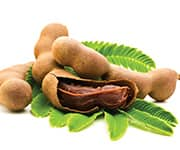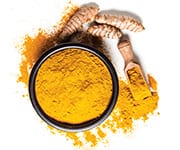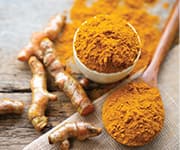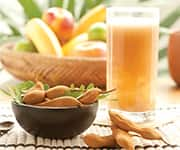Life Extension Magazine®
Joint pain affects many adults, even those without arthritis, making daily activities like walking or bending difficult to perform.1-4
This reduces quality of life.
Most people suffering from chronic joint pain turn to over-the-counter pain medications for relief. These drugs can have dangerous side effects, including an increased risk of heart problems.5,6
Two plant extracts, tamarind and turmeric, have been shown to safely and effectively reduce joint pain and increase joint range of motion.
In a clinical trial of adults with non-arthritic knee joint pain following exercise, 400 mg of a blend of these extracts helped sufferers walk an impressive 137 feet farther in six minutes than those taking a placebo.7
Those taking 400 mg of the extracts also had greater flexibility, were able to climb stairs faster, and reported a stunning 42.8% decrease in scores on a joint-pain scale.7
What Drives Joint Pain?
Joint pain frequently stems from overuse or aging of the joints, which can lead to deteriorating cartilage, limited mobility, and inflammatory changes.8-13
Over time, this results in decreased range of motion, lower quality of life, and reduced muscle strength near the joints.14,15
For many suffering from joint pain, conventional pain medication is the only relief available. However, chronic use of these medications can have lasting effects, including heart damage and kidney failure.5,6,16
Researchers searching for safer alternatives found that two plants, tamarind and turmeric, contain compounds that block inflammation, leading to less joint pain and increased mobility.7
Turmeric’s Anti-Inflammatory Effects
Turmeric has been used in traditional medicine for thousands of years.17,18
Many of its health benefits come from use of turmeric’s rhizome (underground stem), which is an abundant source of polyphenols called curcuminoids.7
The best-known curcuminoid is curcumin, which has powerful anti-inflammatory effects.19,20
In animal and human studies, curcumin has demonstrated a number of benefits, including improvements in cardiovascular health, protection against neuro-degenerative diseases, anti-cancer activity, arthritis relief, and more.21-27
Tamarind Targets Pain
Tamarind is a plant that produces a fruit used in cooking around the world.
It has anti-inflammatory properties that have been shown to alleviate pain in the joints, and it has long been used in traditional medicine to treat pain and inflammation.28,29
Tamarind is rich in another group of polyphenols called procyanidins, which have powerful antioxidant and anti-inflammatory effects.30,31
To test their impact on joint-pain relief, scientists combined these two anti-inflammatory powerhouses.7
Testing in Humans
A team of researchers from the U.S., Netherlands, and India conducted a randomized, controlled clinical trial to test a blend of extracts of tamarind seeds and turmeric rhizome.7
Ninety non-arthritic men and women who experienced knee joint pain and discomfort after physical activity were divided into three groups.
One received a placebo, one received 250 mg daily of the extract blend (in two 125 mg doses), and one received 400 mg daily (in two 200 mg doses).
The study followed participants for 90 days and measured their progress in a few different ways:
- Six-Minute Walk Test: The distance a participant could walk in six minutes.
- Stair-Climb Test: The time it took a participant to walk up and down nine steps.
- Visual Analog Scale: A measurement of pain as described by each participant.
- WOMAC (Western Ontario and McMaster Universities Arthritis Index) Scale: A 24-question assessment of pain, stiffness, and physical limitations.
- Range-of-Motion Knee Flexion: The degree at which participants were able to bend their knee.
Improved Walking Speed and Distance
In any clinical trial, the primary endpoint is the measurement that is assessed to determine if the treatment works.
In this study, the primary endpoint was the Six-Minute Walk Test.
After 90 days, on average:
- Those in the placebo group were able to walk 18 feet farther than they could at the start of the study.
- Those taking 250 mg of the extract blend daily could walk 96 feet farther than at the start of the study.
- Those taking 400 mg of the extracts could walk a whopping 137 feet farther than when the study began.
The walking speed, on average, of those taking the extracts also improved over 90 days:
- Those taking a placebo walked just 0.04 mph faster,
- The 250 mg group walked 0.18 mph faster, and
- The 400 mg group increased their walking speed by 0.24 mph (from 2.51 mph to 2.75 mph).
What you need to know
Plant Extracts Improve Joint Mobility
- Millions of adults suffer from joint pain, which can make daily activities difficult to perform.
- Most pain medications only mask the underlying condition and can lead to other health problems, including heart disease.
- Tamarind and turmeric have been used in traditional medicine for years and have proven anti-inflammatory effects.
- In a clinical study of adults with non-arthritic knee joint pain following exercise, a blend of these extracts dramatically improved mobility, helping sufferers walk farther and faster. Subjects also had increased range of motion in the knee joint, less stiffness, and reported a 46% decrease in joint pain.
Decreased Pain and Stiffness
The secondary endpoints in a clinical trial are other measurements of the treatment’s effectiveness.
In this study, the secondary endpoints were the Stair-Climb Test, the Visual Analog Scale, the WOMAC Test, and the Knee Flexion.
Both doses of the turmeric-tamarind combination improved all of these measures, with the 400 mg dosage showing the most significant results.
After 90 days, those taking 400 mg could walk up and down nine steps 2.4 seconds faster on average, compared to a 0.3-second improvement in the placebo group.
This shows a marked improvement in overall mobility and an increase in the joints’ functionality.
In the subjective Visual Analog scale, those taking 400 mg reported that their pain rating was decreased by 46%, compared to just 10% in the placebo group.
Results of the WOMAC scale were nearly as impressive, with the 400 mg group reporting a 38% reduction in pain, stiffness, and physical limitations, compared to 7% in the placebo group.
Increased Flexibility
A range-of-motion knee flexion test measures the angle in degrees that the knee can be bent away from a straightened position.
After 90 days, those taking the placebo had their knee flexibility increased by an average 0.82% improvement, compared to a 4.34% improvement in knee flexion from baseline in the turmeric-tamarind group. This represented an improvement in knee flexibility more than five times that of the placebo group.
The secondary endpoints confirm the results seen in the walk test: This extract blend decreases joint pain and stiffness while improving joint function and range of motion.
Blocking Inflammation at the Source
There are two key enzymes involved with inflammation:
- 5-LOX, which transforms arachidonic acid into pro-inflammatory compounds called leukotrienes, and
- COX-2, which transforms arachidonic acid into pro-inflammatory mediators such as prostaglandin e2.
Tamarind and turmeric inhibit both these enzymes that are involved in the production of inflammatory compounds.17,32-35
The clinical study described earlier showed that a blend of tamarind and turmeric extracts significantly increased range of motion and reduced joint pain in people with non-arthritic knee joint pain following exercise.7
Summary
Many aging adults experience joint pain, which leads to impaired mobility and reduced quality of life.
Researchers have found that extracts of tamarind and turmeric can improve range of motion and flexibility, and reduce discomfort while also addressing inflammation, without the potentially dangerous side effects of conventional pain medications.
In a study of 90 men and women with non-arthritic knee joint pain following exercise, a combination of these extracts led to improved walking speed and distance, enhanced range of motion, and decreased pain and stiffness after just three months.
If you have any questions on the scientific content of this article, please call a Life Extension Wellness Specialist at 1-866-864-3027.
References
- Available at: https://www.hopkinsmedicine.org/health/conditions-and-diseases/knee-pain-and-problems. Accessed August 23, 2021.
- Pisters MF, Veenhof C, van Dijk GM, et al. The course of limitations in activities over 5 years in patients with knee and hip osteoarthritis with moderate functional limitations: risk factors for future functional decline. Osteoarthritis Cartilage. 2012 Jun;20(6):503-10.
- Feinglass J, Thompson JA, He XZ, et al. Effect of physical activity on functional status among older middle-age adults with arthritis. Arthritis Rheum. 2005 Dec 15;53(6):879-85.
- Rosemann T, Kuehlein T, Laux G, et al. Osteoarthritis of the knee and hip: a comparison of factors associated with physical activity. Clin Rheumatol. 2007 Nov;26(11):1811-7.
- Bally M, Dendukuri N, Rich B, et al. Risk of acute myocardial infarction with NSAIDs in real world use: bayesian meta-analysis of individual patient data. BMJ. 2017 May 9;357:j1909.
- Hsu CC, Wang H, Hsu YH, et al. Use of Nonsteroidal Anti-Inflammatory Drugs and Risk of Chronic Kidney Disease in Subjects With Hypertension: Nationwide Longitudinal Cohort Study. Hypertension. 2015 Sep;66(3):524-33.
- Rao PS, Ramanjaneyulu YS, Prisk VR, et al. A Combination of Tamarindus indica seeds and Curcuma longa Rhizome Extracts Improves Knee Joint Function and Alleviates Pain in Non-Arthritic Adults Following Physical Activity. Int J Med Sci. 2019;16(6):845-53.
- Dainese P, Wyngaert KV, De Mits S, et al. Association between knee inflammation and knee pain in patients with knee osteoarthritis: a systematic review. Osteoarthritis Cartilage. 2021 Dec 27.
- Available at: https://www.rheumatologyadvisor.com/home/topics/osteoarthritis/association-inflammatory-markers-and-pain-in-knee-osteoarthritis-moderate-evidence/. Accessed March 10, 2022.
- Zhu J, Ruan G, Cen H, et al. Association of serum levels of inflammatory markers and adipokines with joint symptoms and structures in participants with knee osteoarthritis. Rheumatology (Oxford). 2022 Mar 2;61(3):1044-52.
- Available at: https://www.mayoclinic.org/symptoms/joint-pain/basics/definition/sym-20050668. Accessed March 10, 2022.
- Available at: https://my.clevelandclinic.org/health/symptoms/17752-joint-pain. Accessed March 10, 2022.
- Sen R HJ. Osteoarthritis. StatPearls Publishing. 2021.
- Henriksen M, Rosager S, Aaboe J, et al. Experimental knee pain reduces muscle strength. J Pain. 2011 Apr;12(4):460-7.
- Kawano MM, Araujo IL, Castro MC, et al. Assessment of quality of life in patients with knee osteoarthritis. Acta Ortop Bras. 2015 Nov-Dec;23(6):307-10.
- Bindu S, Mazumder S, Bandyopadhyay U. Non-steroidal anti-inflammatory drugs (NSAIDs) and organ damage: A current perspective. Biochem Pharmacol. 2020 Oct;180:114147.
- Aggarwal S, Ichikawa H, Takada Y, et al. Curcumin (diferuloylmethane) down-regulates expression of cell proliferation and antiapoptotic and metastatic gene products through suppression of IkappaBalpha kinase and Akt activation. Mol Pharmacol. 2006 Jan;69(1):195-206.
- Hatcher H, Planalp R, Cho J, et al. Curcumin: from ancient medicine to current clinical trials. Cell Mol Life Sci. 2008 Jun;65(11):1631-52.
- Chandran B, Goel A. A randomized, pilot study to assess the efficacy and safety of curcumin in patients with active rheumatoid arthritis. Phytother Res. 2012 Nov;26(11):1719-25.
- Chainani-Wu N. Safety and anti-inflammatory activity of curcumin: a component of tumeric (Curcuma longa). J Altern Complement Med. 2003 Feb;9(1):161-8.
- Li H, Sureda A, Devkota HP, et al. Curcumin, the golden spice in treating cardiovascular diseases. Biotechnol Adv. 2020 Jan - Feb;38:107343.
- Cox KH, Pipingas A, Scholey AB. Investigation of the effects of solid lipid curcumin on cognition and mood in a healthy older population. J Psychopharmacol. 2015 May;29(5):642-51.
- Tomeh MA, Hadianamrei R, Zhao X. A Review of Curcumin and Its Derivatives as Anticancer Agents. Int J Mol Sci. 2019 Feb 27;20(5).
- Daily JW, Yang M, Park S. Efficacy of Turmeric Extracts and Curcumin for Alleviating the Symptoms of Joint Arthritis: A Systematic Review and Meta-Analysis of Randomized Clinical Trials. J Med Food. 2016 Aug;19(8):717-29.
- Ng QX, Koh SSH, Chan HW, et al. Clinical Use of Curcumin in Depression: A Meta-Analysis. J Am Med Dir Assoc. 2017 Jun 1;18(6):503-8.
- Cicero AFG, Sahebkar A, Fogacci F, et al. Effects of phytosomal curcumin on anthropometric parameters, insulin resistance, cortisolemia and non-alcoholic fatty liver disease indices: a double-blind, placebo-controlled clinical trial. Eur J Nutr. 2020 Mar;59(2):477-83.
- Mousavi SM, Milajerdi A, Varkaneh HK, et al. The effects of curcumin supplementation on body weight, body mass index and waist circumference: a systematic review and dose-response meta-analysis of randomized controlled trials. Crit Rev Food Sci Nutr. 2020;60(1):171-80.
- De Caluwé E, Halamová K, Van Damme P. Tamarind (<italic>Tamarindus indica</italic> L.): A Review of Traditional Uses, Phytochemistry and Pharmacology. African Natural Plant Products: New Discoveries and Challenges in Chemistry and Quality. Vol 1021: American Chemical Society; 2009:85-110.
- Rana M, Sharma P, Mahima R, et al. Proximate and phytochemical screening of the seed and pulp of Tamarind indica. Journal of Medicinal Plants Studies. 2018;6(2):111-5.
- Cardoso Lima Reis PM, Dariva C, Barroso Vieira GÂ, et al. Extraction and evaluation of antioxidant potential of the extracts obtained from tamarind seeds (Tamarindus indica), sweet variety. Journal of Food Engineering. 2016;173:116-23.
- Chen L, You Q, Hu L, et al. The Antioxidant Procyanidin Reduces Reactive Oxygen Species Signaling in Macrophages and Ameliorates Experimental Colitis in Mice. Front Immunol. 2017 2018-January-05;8:1910.
- Komakech R, Kim YG, Matsabisa GM, et al. Anti-inflammatory and analgesic potential of Tamarindus indica Linn. (Fabaceae): a narrative review. Integr Med Res. 2019 Sep;8(3):181-6.
- Chun KS, Keum YS, Han SS, et al. Curcumin inhibits phorbol ester-induced expression of cyclooxygenase-2 in mouse skin through suppression of extracellular signal-regulated kinase activity and NF-kappaB activation. Carcinogenesis. 2003 Sep;24(9):1515-24.
- Kunnumakkara AB, Guha S, Krishnan S, et al. Curcumin potentiates antitumor activity of gemcitabine in an orthotopic model of pancreatic cancer through suppression of proliferation, angiogenesis, and inhibition of nuclear factor-kappaB-regulated gene products. Cancer Res. 2007 Apr 15;67(8):3853-61.
- Ponnurangam S, Mondalek FG, Govind J, et al. Urine and serum analysis of consumed curcuminoids using an IkappaB-luciferase surrogate marker assay. In Vivo. 2010 Nov-Dec;24(6):861-4.









